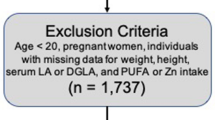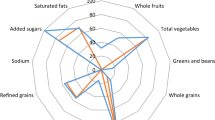Abstract
Background/Objectives:
Although there is an increasing trend of dietary supplement (DS) use, few researches have evaluated nutrient intake from DS. This study aimed to establish a nutrient database (NDB) for DS and estimate the effect of DS on total nutrient intake by Korean adults.
Subjects/Methods:
The NDB for DS was established using the label information of products reported in the Korea National Health and Nutrition Examination Survey (KNHANES) IV. Of the 16 031 participants who were ⩾20 years old, 2053 products were reported as being taken by 5606 subjects. But nutrient composition could be identified by searching product name only in 1158 products consumed by 3844 subjects (DS users). Total nutrient intake of DS users was obtained by combining intakes from diet and DS.
Results:
Dietary supplement use was higher in women, in middle-aged people and in those with higher education and low smoking and drinking preferences. Nutrients obtained from food were higher in DS users than in nonusers for most nutrients, particularly in women. When total nutrient intake was evaluated in DS users, the percentage of subjects whose intake was below the estimated average requirement for Koreans decreased for several vitamins and minerals, but the percentage of subjects whose intake was above the tolerable upper intake levels increased for vitamin A, vitamin C and iron.
Conclusions:
The newly developed NDB for DS will be an important resource for more accurate assessment of nutrient intake as well as evaluation of the relationship between nutrition and health. Further research is needed to update a more comprehensive NDB applicable to diverse populations.
This is a preview of subscription content, access via your institution
Access options
Subscribe to this journal
Receive 12 print issues and online access
$259.00 per year
only $21.58 per issue
Buy this article
- Purchase on Springer Link
- Instant access to full article PDF
Prices may be subject to local taxes which are calculated during checkout


Similar content being viewed by others
References
Lee JS, Kim JS . Factors affecting the use of dietary supplements by Korean adults: data from the Korean National Health and Nutrition Examination Survey III. J Am Diet Assoc 2009; 109: 1599–1605.
Korea Centers for Disease Control and Prevention. Korea Health Statistics 2009: Korea National Health and Nutrition Examination Survey (KNHANES IV-3). Korea Centers for Disease Control and Prevention, Ministry of Health and Welfare: Seoul, Korea, 2010.
Gahche J, Bailey R, Burt V, Hughes J, Yetley E, Dwyer J et al. Dietary supplement use among US adults has increased since NHANES III (1988-1994). NCHS Data Brief 2011; 61: 1–8.
Henderson L, Irving K, Gregory J, Bates CJ, Prentice A, Perks J et al. The National Diet & Nutrition Survey: Adults Aged 19 to 64 Years. Vol 3: Vitamin and Mineral Intake and Urinary Analytes. TSO: London, UK, 2003.
Bates B, Lennox A, Prentice A, Bates C, Swan G . National Diet and Nutrition Survey. Headline Results from Years 1 and 2 (Combined) of the Rolling Programme (2008/2009–2009/2010). Department of Health and Food Standards Agency: London, UK, 2011.
Yoo YJ, Hong WS, Choi YS . The experience of nutrient supplement use among adults in the Seoul area. J Korean Soc Food Sci Nutr 2001; 30: 357–363.
Kim YJ, Mun JA, Min HS . Supplement dose and health-related life style of vitamin-mineral supplement user among Korean middle-aged. Korean J Community Nutrition 2004; 9: 303–314.
Song BC, Kim MK . Patterns of vitamin-mineral supplement usage by the elderly in Korea. Korean J Nutr 1997; 30: 139–146.
Chung HK, Lee HY . Consumption of health functional foods according to age group in some regions of Korea. J Korean Diet Assoc 2011; 17: 190–205.
Kim SH . A study on the use of health functional foods and its related influencing factors of university students in Korea. Korean J Food Culture 2010; 25: 150–159.
Kim SH, Han JH, Kim WY . Health functional food use and related variables among the middle-aged in Korea. Korean J Nutr 2010; 43: 294–303.
Kennedy ET, Luo H, Houser RF . Dietary supplement use pattern of U.S. adult population in the 2007-2008 National Health and Nutrition Examination Survey (NHANES). Ecol Food Nutr 2013; 52: 76–84.
Murphy SP, White KK, Park S-Y, Sharma S . Multivitamin-multimineral supplements' effect on total nutrient intake. Am J Clin Nutr 2007; 85: 280S–284S.
Burnett-Hartman AN, Fitzpatrick AL, Gao K, Jackson SA, Schreiner PJ . Supplement use contributes to meeting recommended dietary intakes for calcium, magnesium, and vitamin C in four ethnicities of middle-aged and older Americans: the Multi-Ethnic Study of Atherosclerosis. J Am Diet Assoc 2009; 109: 422–429.
Block G, Sinha R, Gridley G . Collection of dietary-supplement data and implications for analysis. Am J Clin Nutr 1994; 59: 232S–239S.
Korea Centers for Disease Control and Prevention. The Fourth Korea National Health and Nutrition Examination Survey(KNHANES IV). Korea Centers for Disease Control and Prevention, Ministry of Health and Welfare: Seoul, Korea, 2010.
Kim DW, Shim JE, Paik HY, Song WO, Joung HJ . Nutritional intake of Korean population before and after adjusting for within-individual variations: 2001 Korean National Health and Nutrition Survey Data. Nutr Res Pract 2011; 5, 266–274.
The Korean Nutrition Society. Dietary reference intakes for Koreans, 1st revision. The Korean Nutrition Society: Seoul, Korea, 2010.
Kim JS, Lee JS, Shin AS, Kang MH, Shin DS, Chung HR et al. Sociodemographic and lifestyle factors are associated with the use of dietary supplements in a Korean population. J Epidemiol 2010; 20: 197–203.
Ock SM, Hwang SS, Lee JS, Song CH, Ock CM . Dietary supplement use by South Korean adults: Data from the national complementary and alternative medicine use survey (NCAMUS) in 2006. Nutr Res Pract 2010; 4: 69–74.
Pouchieu C, Andreeva VA, Péneau S, Kesse-Guyot E, Lassale C, Hercberg S et al. Sociodemographic, lifestyle and dietary correlates of dietary supplement use in a large sample of French adults: results from the NutriNet-Sante cohort study. Br J Nutr 2013; 110: 1480–1491.
Harrison R, Holt D, Pattison D, Elton P . Are those in need taking dietary supplements? A survey of 21 923 adults. Br J Nutr 2004; 91: 617–624.
Radimer K, Bindewald B, Hughes J, Ervin B, Swanson C, Picciano MF . Dietary supplement use by US adults: data from the National Health and Nutrition Examination Survey, 1999–2000. Am J Epidemiol 2004; 160: 339–349.
Foote JA, Murphy SP, Wilkens LR, Hankin JH, Henderson BE, Kolonel LN . Factors associated with dietary supplement use among healthy adults of five ethnicities: the Multiethnic Cohort Study. Am J Epidemiol 2003; 157: 888–897.
Giammarioli S, Boniglia C, Carratu B, Ciarrocchi M, Chiarotti F, Mosca M et al. Use of food supplements and determinants of usage in a sample Italian adult population. Pub Health Nutr 2012; 16: 1768–1781.
Reinert A, Rohrmann S, Becker N, Linseisen P . Lifestyle and diet in people using dietary supplements. Eur J Nutr 2007; 46: 165–173.
Lee YO, Song YJ . Sociodemographic characteristics, lifestyle factors, and nutrient intake by taking vitamin/mineral supplements. Korean J Food Culture 2010; 25: 480–486.
Bailey RL, Fulgoni VL, Keast DR, Dwyer JT . Examination of vitamin intakes among US adults by dietary supplement use. J Acad Nutr Diet 2012; 112: 657–663.
Bailey RL, Fulgoni VL, Keast DR, Dwyer JT . Dietary supplement use is associated with higher intakes of minerals from food sources. Am J Clin Nutr 2011; 94: 1376–1381.
Shakur YA, Tarasuk V, Corey P, O’Connor DL . A comparison of micronutrient inadequacy and risk of high micronutrient intakes among vitamin and mineral supplement users and nonusers in Canada. J Nutr 2012; 142: 534–540.
Yonemori KM, Morimoto Y, Wilkens LR, Murphy SP . Development of a supplement composition database for the SURE study. J Food Compos Anal 2009; 22: S83–S87.
Reinivuo H, Marjamäki L, Heikkilä M, Virtanen SM, Valsta L . Revised Finnish dietary supplement database. J Food Compos Anal 2008; 21: 464–468.
Dwyer J, Picciano MF, Raiten DJ . Food and dietary supplement databases for what we eat in America–NHANES. J Nutr 2003; 133: 624S–634S.
Author information
Authors and Affiliations
Corresponding author
Ethics declarations
Competing interests
The authors declare no conflict of interest.
Rights and permissions
About this article
Cite this article
Kang, M., Kim, D., Baek, Y. et al. Dietary supplement use and its effect on nutrient intake in Korean adult population in the Korea National Health and Nutrition Examination Survey IV (2007–2009) data. Eur J Clin Nutr 68, 804–810 (2014). https://doi.org/10.1038/ejcn.2014.77
Received:
Revised:
Accepted:
Published:
Issue Date:
DOI: https://doi.org/10.1038/ejcn.2014.77
This article is cited by
-
Association between use of vitamin and mineral supplement and non-alcoholic fatty liver disease in hypertensive adults
Scientific Reports (2023)
-
Prevalence of Use of Traditional, Complementary and Alternative Medicine by the General Population: A Systematic Review of National Studies Published from 2010 to 2019
Drug Safety (2022)
-
Estimation of dietary total antioxidant capacity of Korean adults
European Journal of Nutrition (2018)
-
The nutrition contribution of dietary supplements on total nutrient intake in children and adolescents
European Journal of Clinical Nutrition (2016)
-
Gender difference on the association between dietary patterns and metabolic syndrome in Korean population
European Journal of Nutrition (2016)



